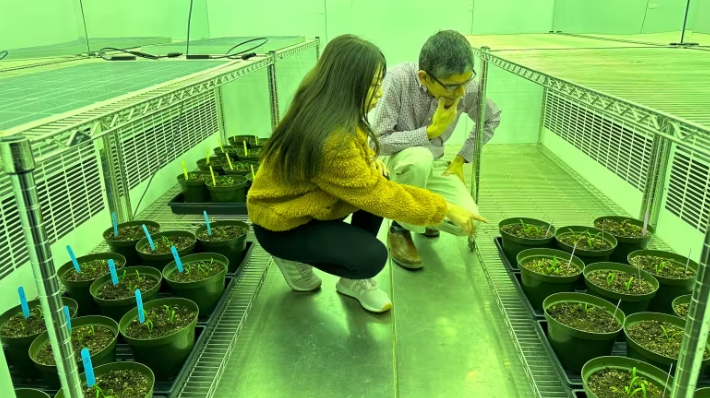Spinach and sheep are showing us that solar farms aren’t solely for green energy

University of Alberta team grows plants under solar panels in laboratory test
New work from the University of Alberta is looking to maximize the green energy that comes from the province’s solar farms.
The practice is known as agrivoltaics — placing crops under solar panels, effectively doubling down on the efficiency of a booming solar energy sector. In this case, the crop is spinach.
“In several ways it’s a win-win,” said soil scientist Guillermo Hernandez Ramirez, a professor in the U of A’s faculty of agricultural, life and environmental sciences.
Solar farms require a significant amount of land, a challenge that has drawn criticism from the agricultural community and from some opponents of renewable energy initiatives.
EPCOR’s kīsikāw pīsim solar farm covers 21 hectares in southwest Edmonton. On the other end of the scale is the Travers Solar Project in Lomond, Alta. It spreads across 1,350 hectares and is currently the largest in Canada.

The U of A pilot project, run by Hernandez Ramirez and research intern Camila Quiroz, was a 25-day laboratory test to see if solar farms can do double duty.
Research was conducted in a growth chamber that compared the growth of spinach in three conditions: under a thin solar panel, under a thick solar panel, and uncovered.
Spinach plants under solar panels consumed up to 17 per cent less water — and though their growth was slower, the plant’s overall health wasn’t affected.
And while they grew, the plants kept the area underneath the panels cool, which improved the solar panels’ efficiency.
“There is a synergy here,” said Hernandez Ramirez.
It’s about “trying to use the space in a more efficient way,” he said. “We are able to combine the two efforts, the challenge of energy transition and the challenge of food security.”
‘Growing food, fibres and fertilizer’
Spinach isn’t the only thing that can thrive on a solar farm.
In 2012, Janna Greir and her husband Ryan started Whispering Cedars Ranch near Strathmore, Alta. Last year they moved 450 sheep to a graze at Strathmore Solar, a 130-hectare project run by Edmonton-based Capital Power.
The flock returned to the solar farm in May. The sheep will be there until October, offering affordable and effective lawn maintenance. In turn, the solar panels will give the animals shade while they graze.
“We’re growing food, fibres and fertilizer underneath green energy. You don’t get any better than that,” Janna Greir said.
The American Solar Grazing Association was founded in 2018 to promote sheep grazing on solar installations in the United States. Sheep are used on many solar farms in Ontario, but the idea is relatively new to Alberta.

Access to a large parcel of land has been a game changer for the Greirs as first-generation farmers, and now they’re being approached by other solar projects and farms interested in opportunities.
Grazing sheep helps challenge the notion that solar farms are a strain on agricultural land, Janna said.
“It’s saying that land can still be productive,” she said. “Agrivoltaics is changing that.”
Doing double-duty in a green future
Hernandez Ramirez hopes the U of A’s research will lead to a wider array of crops grown on solar farms and says the work is scalable, meaning solar panels and plants could end up on balconies, in backyards or in city green spaces — generating food and electricity.
Making agrivoltaics accessible is something he thinks could benefit communities across the country, whether it’s spinach or sheep.
“If people are able to engage,” Hernandez Ramirez said, “they might feel more connected to where their energy comes from and also where their food comes from.”
Related News
Trade war, slumping border traffic: What does that mean for the Gordie Howe bridge?
Amid U.S. President Donald Trump’s tariffs which have triggered a trade war with Canada, cross-border trips haveRead more
Trump administration threatens Harvard’s foreign enrolment, tax-exempt status
U.S. Homeland Security Secretary Kristi Noem speaks during an event on April 9, in Washington,Read more
